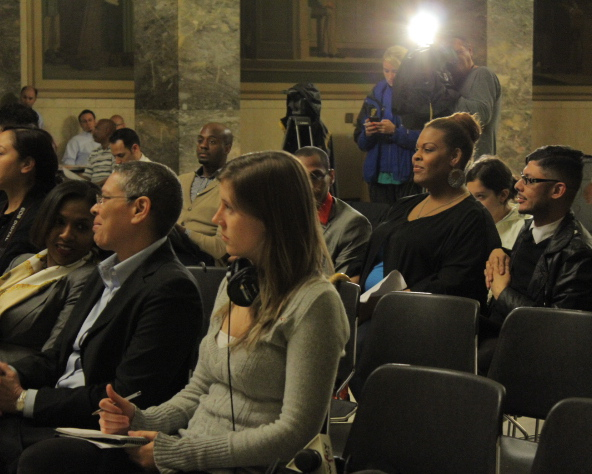
Photo by: Naomi Cohen
The Bronx LGBTQ Center, which hosted the press conference last week, is still struggling to build a strong presence following a year of outreach.
As much as it was about supporting the Bronx gay community, a Friday press conference — sponsored by the new LGBTQ Community Center of the Bronx, Borough President Ruben Diaz, Jr. and State Senator Jose Serrano — was about introspection.
Diaz, a Puerto Rican, called out the Latino community for nurturing homophobia responsible for hate crimes. District 15 City Council candidate Cynthia Tompkins, a mixed-race lesbian, criticized the white and black communities for not accepting her and faulted lesbians in general for not participating strongly in the movement. And Rev. James Dusenbury criticized the faith community for rejecting its own followers because of their sexuality.
“Today, I look at what is going on in our LGBT community and I am frustrated, I am looking for justice, I am seeking equality,” Thompkins said. “To hear about my community being beaten and killed—a place where we are supposed to feel so safe, and now we are so scared to even walk alone or even in pairs. We shouldn’t have to live like that. We aren’t going to live like that.”
A year after the arrest of the Bronx Pride Center’s director Lisa Winters for embezzling over $143,000, the LGBTQ Center, which rose from the Pride Center’s ashes, still has no money, no clients and no physical space.
“We’re in the shadow of what happened,” said Tym Moss, the Center’s unsalaried director. “There’s just no doubt about it, and there’s no way around it.” Still, Moss believes there could be a silver lining in the demise of the Pride Center. With a new name, a new volunteer staff, a new membership-based model, a new practice of full transparency, and a new mission and vision, Moss says the new Center will be molded as the community sees fit. While the level of community participation is still less than desired, the new Center has open and public board meetings (Winters had all invoices sent directly to her home), diversified funding (97 percent of the Bronx Pride Center’s funding came from the government) and broader, more inclusive services (white gay and trans youth made the most use of the Pride Center’s services, which were mostly HIV and health-focused).
The only similarity appears to be their need to learn what has been successful beyond the Bronx.
“It’s so important for people to know that there’s a place to go where other people that think like you go,” Moss said. “It’s so you don’t feel so alone in this world.” Unlike the other boroughs, the Bronx has no space that is regularly frequented by its gay population, either in the form of a nonprofit center, a commercial establishment or an informal hangout spot. At the Center’s current pace of outreach and fundraising, though, a space won’t exist for at least another two years, and a building in another five or 10.
In the meantime, Moss and Frank are focusing on outreach and lower-scale programming. Frustrated with the lack of interest, coverage and solidarity in the Bronx, especially after the surge in city hate crimes, the LGBTQ Center organized the press conference and reached out to colleagues in other boroughs in the hopes of reaching friends of Bronx residents.
“In the Bronx more than any other borough,” said the Center’s secretary Peter Frank, “there’s a great a reluctance to come out and bond because there are so many that are on the DL [the “down low,” or only engaging in homosexual activity privately] or in the closet because of all the homophobia and transphobia that exists there.”
Other Bronx organizations that cater to the gay community are sparse—though there is an all-gay church, a gay arts center and a new gay shelter—so the Center’s strategy for now is to go door-to-door and event-to-event to build visibility and trust.
“In other boroughs, it’s all in motion,” Moss said. “We just want to set this one in motion, as well.”
Though Moss said the LGBTQ Center’s programs would be determined by the community, he isn’t short of ideas. In the short term, the Center plans to offer a legal clinic, community safety nights, a Pride and Health fair, self-defense workshops, town hall meetings, a peer support network and a family holidays program. Eventually, it would like to offer recreational programming, day trips, an anti-bullying campaign and an educational program for parents of gay youth.
To launch these initiatives, the Center has the strong support of the Union Community Health Center, SCAN New York, NYC LGBTQS Chamber of Commerce, the Bronx Pride Coalition—a health group which also emerged from the Pride Center’s collapse—and 32 gay entertainers across the city. Still, the Center’s first fundraiser gala, in March at the Manhattan Club Revel, had a more enthusiastic showing from the entertainment community than from the Bronx community.
“I want to try to reach the kid who’s in his room in the apartment on the Grand Concourse who’s afraid to tell his parents that he’s gay because of his macho dad, what his macho dad might do or in fear that he might get kicked out on the street,” Moss said. “I want to reach out to those kids that are being told that they’re wrong for the way they are, and I want them to know that there’s a safe place that they can go and be told that you’re perfect; you’re perfect exactly as you are.”








